Changes in Stream–Aquifer Interactions Due to Gate Opening of the Juksan Weir in Korea
Abstract
:1. Introduction
2. Materials and Methods
2.1. Study Area and Hydrogeological Setting
2.2. Model Development
2.3. Model Calibration
3. Results and Discussion
3.1. Analysis of Groundwater Level Decline
3.2. Impacts of Water Gate Operation on Stream–Aquifer Interaction
3.3. Changes in Groundwater Quality
4. Conclusions
Author Contributions
Funding
Institutional Review Board Statement
Informed Consent Statement
Data Availability Statement
Conflicts of Interest
References
- Jeong, S.J.; Koo, M.H. Analyzing the effect of a weir construction on the groundwater flow system. J. Soil Groundw. Environ. 2012, 17, 39–48. (In Korean) [Google Scholar] [CrossRef] [Green Version]
- Djuma, H.; Bruggeman, A.; Camera, C.; Eliades, M.; Kostarelos, K. The impact of a check dam on groundwater recharge and sedimentation in an ephemeral stream. Water 2017, 9, 813. [Google Scholar] [CrossRef] [Green Version]
- Lee, H.; Koo, M.H.; Kim, K.; Kim, Y. Spatio-temporal variations in stream-aquifer interactions following construction of weirs in Korea. Groundwater 2016, 54, 448–458. [Google Scholar] [CrossRef]
- Kim, G.B.; Cha, E.J.; Jeong, H.G.; Shin, K.H. Comparison of time series of alluvial groundwater levels before and after barrage construction on the lower Nakdong River. J. Eng. Geol. 2013, 23, 105–115. (In Korean) [Google Scholar] [CrossRef] [Green Version]
- Shin, S.E.; Youn, S.T.; Koh, Y.K.; Oh, K.H. The geochemical characteristics and environmental changes of surface sediments in Yeongsan River area. J. Korean Geomorphol. Assoc. 2015, 22, 31–42. (In Korean) [Google Scholar]
- Cho, H.K.; Lim, H.J.; Kim, S.M. Comparison of water quality before and after four major river project for water monitoring stations located near 8 weirs in Nakdong River. J. Agric. Life Sci. 2018, 52, 89–101. (In Korean) [Google Scholar] [CrossRef]
- Kim, Y.W.; Lee, J.H.; Park, T.J.; Byun, I.G. Variation of water environment and algae occurrence characteristics after weirs construction at Mulgeum site in downstream of the Nakdong River. J. Korean Soc. Hazard Mitig. 2017, 17, 383–392. (In Korean) [Google Scholar] [CrossRef]
- Oh, S.E.; Ahn, H.K.; Chae, S.K. The study on the prediction of algae occurrence by the multiple regression analysis after weir construction at Namhan River. J. Environ. Impact Assess. 2017, 26, 470–478. (In Korean) [Google Scholar]
- Shin, Y.; Yu, H.; Lee, H.; Lee, D.; Park, G. The change in patterns and conditions of algal blooms resulting from construction of weirs in the Youngsan River: Long-term data analysis. Korean J. Ecol. Environ. 2015, 48, 238–252. (In Korean) [Google Scholar] [CrossRef]
- Lee, S.M.; Kim, I.K. Analysis of correlation between cyanobacterial population and water quality factors in the middle and down stream region of nakdong river. J. Korean Soc. Water Wastewater 2017, 31, 93–101. (In Korean) [Google Scholar] [CrossRef]
- Ji, U.; Jang, E.K.; Kim, W. Long-term bed change analysis and equilibrium bed elevation prediction after weir construction in Nakdong River. J. Korea Acad. Ind. 2015, 16, 7089–7097. (In Korean) [Google Scholar]
- Jeong, A.; Jung, K. Analysis of long-term riverbed-level and flood stage variation due to water fate operation of multi-functional weirs at Geum River. J. Korea Water Resour. Assoc. 2015, 48, 379–391. (In Korean) [Google Scholar] [CrossRef] [Green Version]
- Krause, S.; Heathwaite, L.; Binley, A.; Keenan, P. Nitrate concentration changes at the groundwater-surface water interface of a small Cumbrian river. Hydrol. Process. 2009, 23, 2195–2211. [Google Scholar] [CrossRef]
- Levitt, D.G.; Newell, D.L.; Stone, W.J.; Wykoff, D.S. Surface water-groundwater connection at the Los Alamos Canyon weir site: Part 1. Monitoring site installation and tracer tests. Vadose Zone J. 2005, 4, 708–717. [Google Scholar] [CrossRef] [Green Version]
- Matula, S.; Mekonnen, G.B.; Batkova, K.; Nesetril, K. Simulations of groundwater-surface water interaction and particle movement due to the effect of weir construction in the sub-watershed of the river Labe in the town of Decin. Environ. Monit. Assess. 2014, 186, 7755–7770. [Google Scholar] [CrossRef] [PubMed]
- Yang, C.; Zhang, Y.K.; Liu, Y.; Yang, X.; Liu, C. Model-based analysis of the effects of dam-induced river water and groundwater interactions on hydro-biogeochemical transformation of redox sensitive contaminants in a hyporheic zone. Water Resour. Res. 2018, 54, 5973–5985. [Google Scholar] [CrossRef]
- Ray, C.; Soong, T.W.; Lian, Y.Q.; Roadcap, G.S. Effect of flood-induced chemical load on filtrate quality at bank filtration sites. J. Hydrol. 2002, 266, 235–258. [Google Scholar] [CrossRef]
- Lee, H.; Koo, M.H.; Kim, Y. Impacts of seasonal pumping on stream-aquifer interactions in Miryang, Korea. Groundwater 2017, 55, 906–916. [Google Scholar] [CrossRef]
- Moon, S.H.; Kim, Y.; Jeong, Y.Y.; Hwang, J. Groundwater-stream water interaction induced by water curtain cultivation activity in Sangdae-ri area of Cheongju, Korea. Econo. Environ. Geol. 2016, 49, 105–120. (In Korean) [Google Scholar] [CrossRef] [Green Version]
- Wu, B.; Zheng, Y.; Wu, X.; Tian, Y.; Han, F.; Liu, J.; Zheng, C. Optimizing water resources management in large river basins with integrated surface water-groundwater modeling: A surrogate-based approach. Water Resour. Res. 2015, 51, 2153–2173. [Google Scholar] [CrossRef]
- Ahn, S.R.; Kim, S.J. Analysis of water balance by surface-groundwater interaction using the SWAT model for the Han River basin, South Korea. Paddy Water Environ. 2018, 16, 543–560. [Google Scholar] [CrossRef]
- Lee, H.; Koo, M.H.; Cho, B.W.; Oh, Y.H.; Kim, Y.; Cho, S.Y.; Lee, J.Y.; Kim, Y.; Kim, D.H. Effects of Baekje Weir Operation on the Stream–Aquifer Interaction in the Geum River Basin, South Korea. Water 2020, 12, 2984. [Google Scholar] [CrossRef]
- Jung, B.; Kim, D.H.; Moon, H.S.; Kimg, Y. Quantifying effects of river stage control on groundwater system by cluster analysis and groundwater-level modeling. J. Geol. Soc. Korea 2021, 57, 79–97. (In Korean) [Google Scholar] [CrossRef]
- Waterloo Hydrogeologic. Visual Modflow Flex 6.1 User’s Manual; Waterloo Hydrogeologic: Waterloo, ON, Canada, 2019. [Google Scholar]
- Lee, G.R. Study on types and distribution properties of abandoned channels in Korea. Korean Geogr. Soc. 2011, 46, 304–318. (In Korean) [Google Scholar]
- Korea Institute of Geoscience and Mineral Resources. 1: 50,000 Geological Report of the Yeongsanpo Sheet; Korea Institute of Geoscience and Mineral Resources: Daejeon, Korea, 2015. (In Korean) [Google Scholar]
- Strack, O.D.L. Groundwater Mechanics; Prentice Hall: Englewood Cliffs, NJ, USA, 1989; ISBN 0-13-365412-5. [Google Scholar]
- Reddy, J.N. An Introduction to the Finite Element Method; McGraw-Hill: New York, NY, USA, 2010; ISBN 9780071267618. [Google Scholar]
- Grossmann, C.; Roos, H.G.; Stynes, M. Numerical Treatment of Partial Differential Equations; Springer: Berlin/Heidelberg, Germany, 2007; ISBN 978-3-540-71584-9. [Google Scholar]
- Rozos, E.; Koutsoyiannis, D. Error analysis of a multi-cell groundwater model. J. Hydrol. 2010, 392, 22–30. [Google Scholar] [CrossRef]
- McDonald, M.G.; Harbaugh, A.W. The history of MODFLOW. Groundwater 2003, 41, 280–283, PMID 12656294. [Google Scholar] [CrossRef]
- Colombera, L.; Mountney, N.P.; Medici, G.; West, L.J. The geometry of fluvial channel bodies: Empirical characterization and implications for object-based models of the subsurface. AAPG Bull. 2019, 103, 905–929. [Google Scholar] [CrossRef]
- Medici, G.; West, L.J.; Mountney, N.P. Sedimentary flow heterogeneities in the Triassic UK Sherwood Sandstone Group: Insights for hydrocarbon exploration. Geol. J. 2019, 54, 1361–1378. [Google Scholar] [CrossRef]
- Heeren, D.M.; Fox, G.A.; Fox, A.K.; Storm, D.E.; Miller, R.B.; Mittelstet, A.R. Divergence and flow direction as indicators of subsurface heterogeneity and stage-dependent storage in alluvial floodplains. Hydrol. Process. 2014, 28, 1307–1317. [Google Scholar] [CrossRef] [Green Version]
- Thomas, E.R. System and Boundary Conceptualization in Groundwater Flow Simulation, Techniques of Water-Resources Investigations of U.S.; U.S. Geological Survey: Reston, VA, USA, 2001.
- Korea Water Resources Corporation. Groundwater Basic Survey Report of Naju Area; Korea Water Resources Corporation: Deajeon, Korea, 2010. (In Korean) [Google Scholar]
- Ministry of Environment. Report of Effect of the Weir Operation on Groundwater; Ministry of Environment: Sejong, Korea, 2018. (In Korean)
- Waterloo Hydrogeologic. Visual Modflow Premium 4.2 User’s Manual; Waterloo Hydrogeologic: Waterloo, ON, Canada, 2006. [Google Scholar]
- Sophocleous, M. Interactions between groundwater and surface water: The state of the science. Hydrogeol. J. 2002, 10, 52–67. [Google Scholar] [CrossRef]
- Lee, J.H.; Hamm, S.Y.; Lee, C.M.; Lee, J.; Kim, H.S.; Kim, G.B. Numerical simulation of groundwater system change in a riverside area due to the construction of an artificial structure. J. Eng. Geol. 2012, 22, 263–274. (In Korean) [Google Scholar] [CrossRef]
- Francis, B.A.; Francis, L.K.; Cardenas, M.B. Water table dynamics and groundwater–surface water interaction during filling and draining of a large fluvial island due to dam–induced river stage fluctuations. Water Resour. Res. 2010, 46, W07513. [Google Scholar] [CrossRef]
- Thin, K.C.; Khaing, M.M.; Aye, K.M. Design and performance analysis of centrifugal pump. World Acad. Sci. Eng. Technol. 2008, 46, 422–429. [Google Scholar]
- Lee, H.; Koo, M.H.; Oh, S. Modeling stream-aquifer interactions under seasonal groundwater pumping and managed aquifer recharge. Groundwater 2019, 57, 216–225. [Google Scholar] [CrossRef]
- Hillel, N.; Wine, M.L.; Laronne, J.B.; Licha, T.; Be’eri-Shlevin, Y.; Siebert, C. Identifying spatiotemporal variations in groundwater–surface water interactions using shallow pore water chemistry in the lower Jordan River. Adv. Water Resour. 2019, 131, 103388. [Google Scholar] [CrossRef]
- Korea Environment Corporation. Groundwater Quality Survey Report of the Groundwater Quality Monitoring Wells; Korea Environment Corporation: Incheon, Korea, 2018. (In Korean) [Google Scholar]
- Piper, A.M. A graphic procedure in the geochemical interpretation of water-analyses. Eos Trans. Am. Geophys. Union 1944, 25, 914–928. [Google Scholar] [CrossRef]
- Kumar, P.; Dasgupta, R.; Johnson, B.A.; Saraswat, C.; Basu, M.; Kefi, M.; Mishra, B.K. Effect of land use changes on water quality in an ephemeral coastal plain: Khambhat City, Gujarat, India. Water 2019, 11, 724. [Google Scholar] [CrossRef] [Green Version]
- Shimojima, E.; Sharma, M.L. The influence of pore water velocity on transport of sorptive and non-sorptive chemicals through an unsaturated sand. J. Hydrol. 1995, 164, 239–261. [Google Scholar] [CrossRef]
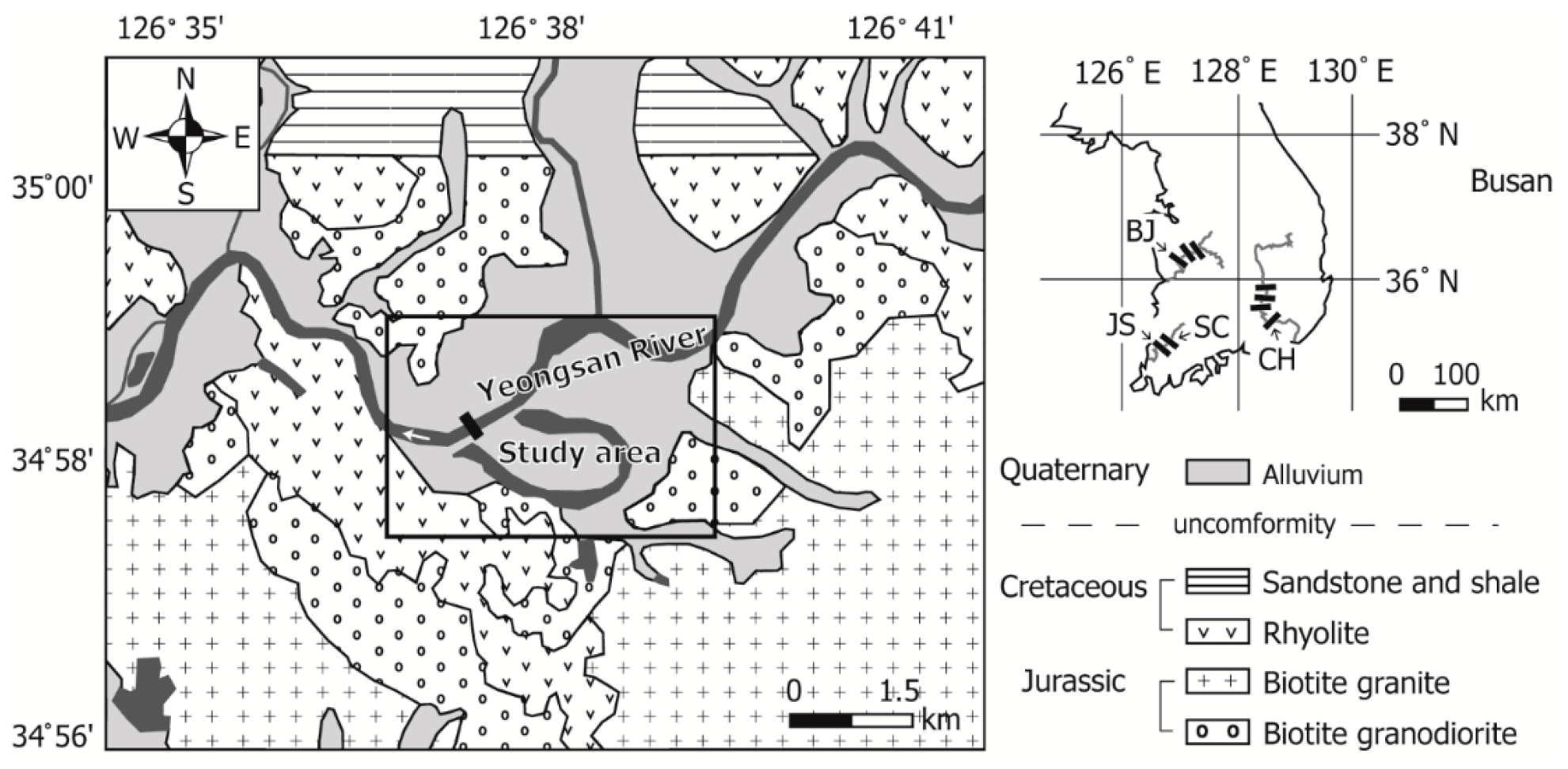

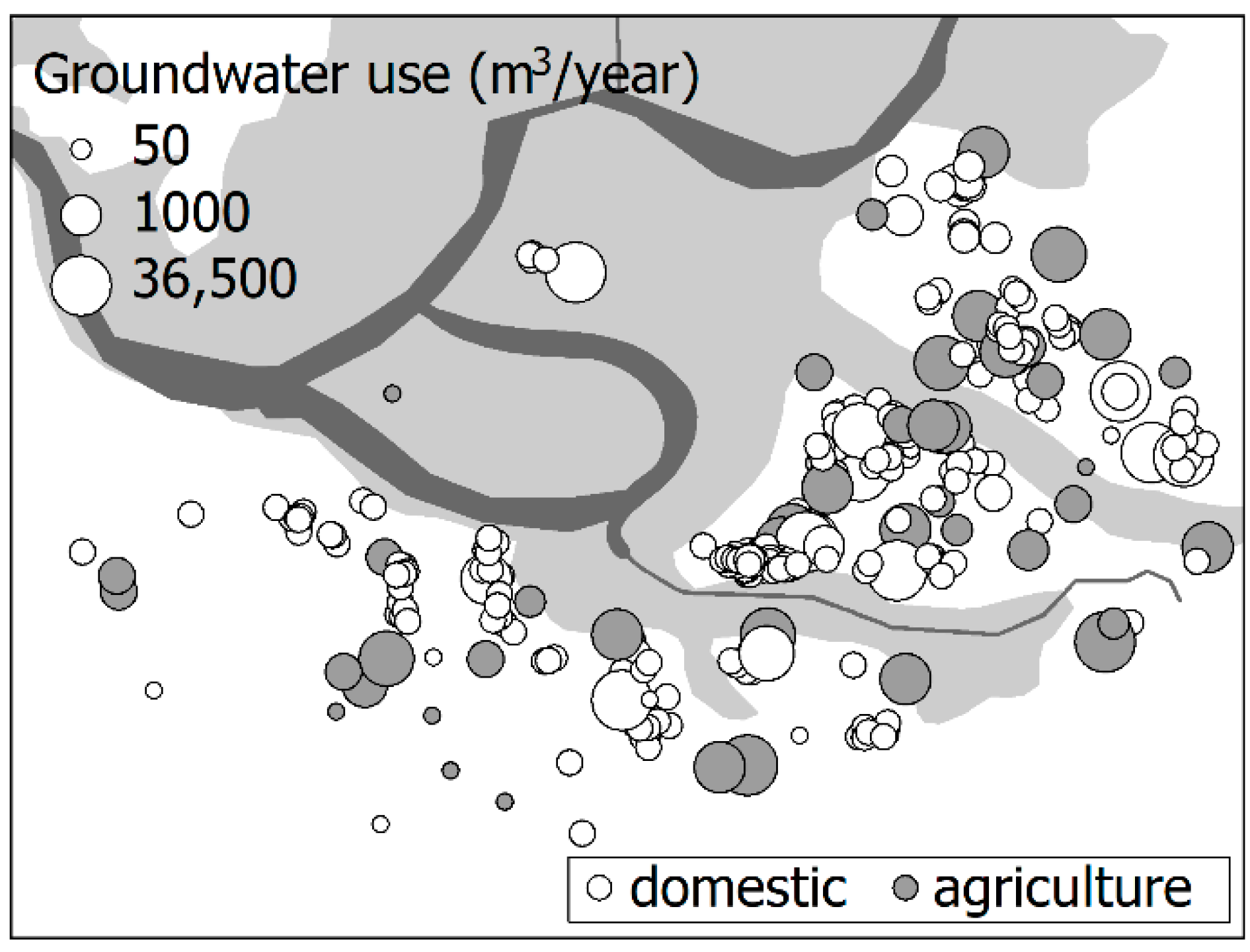
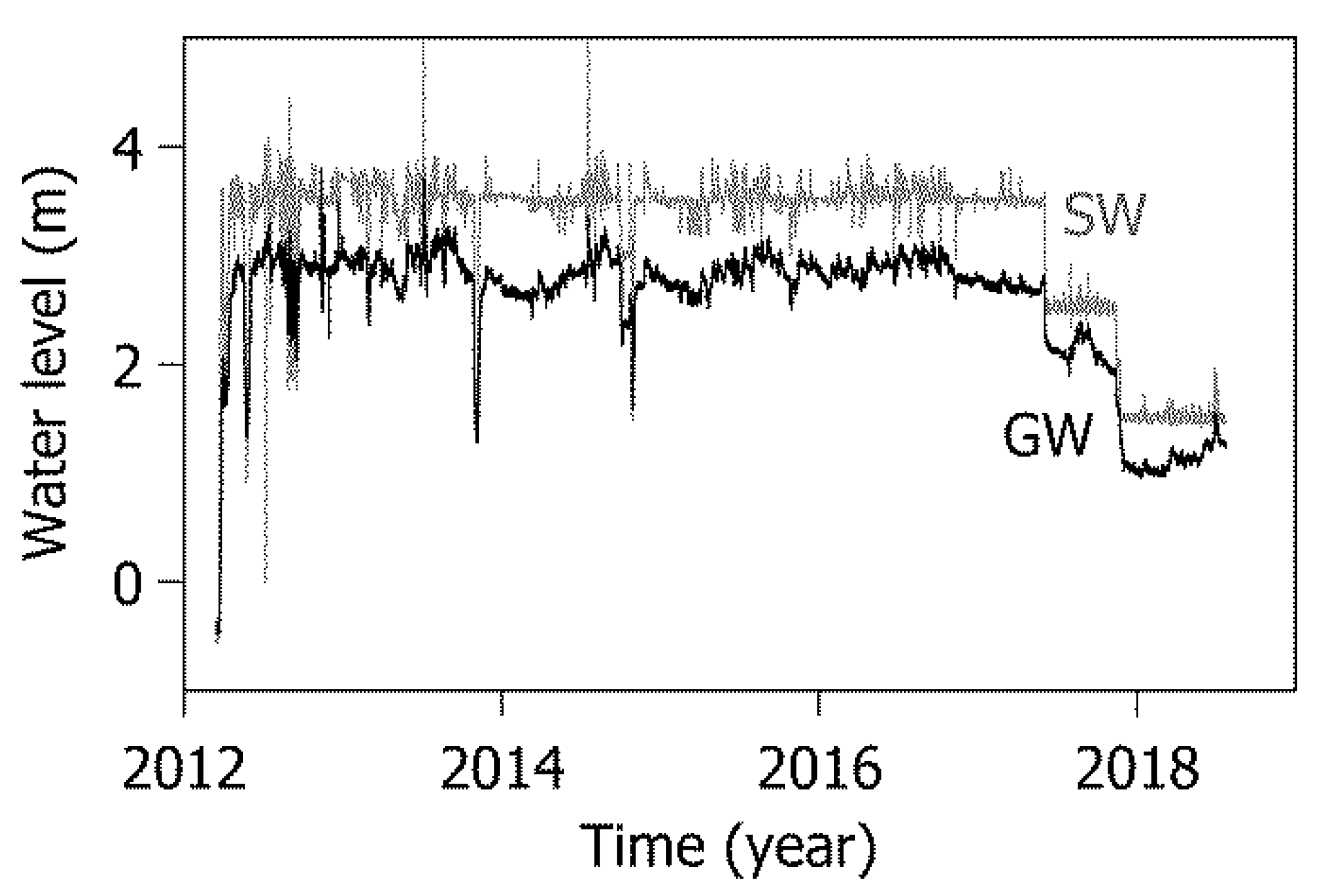
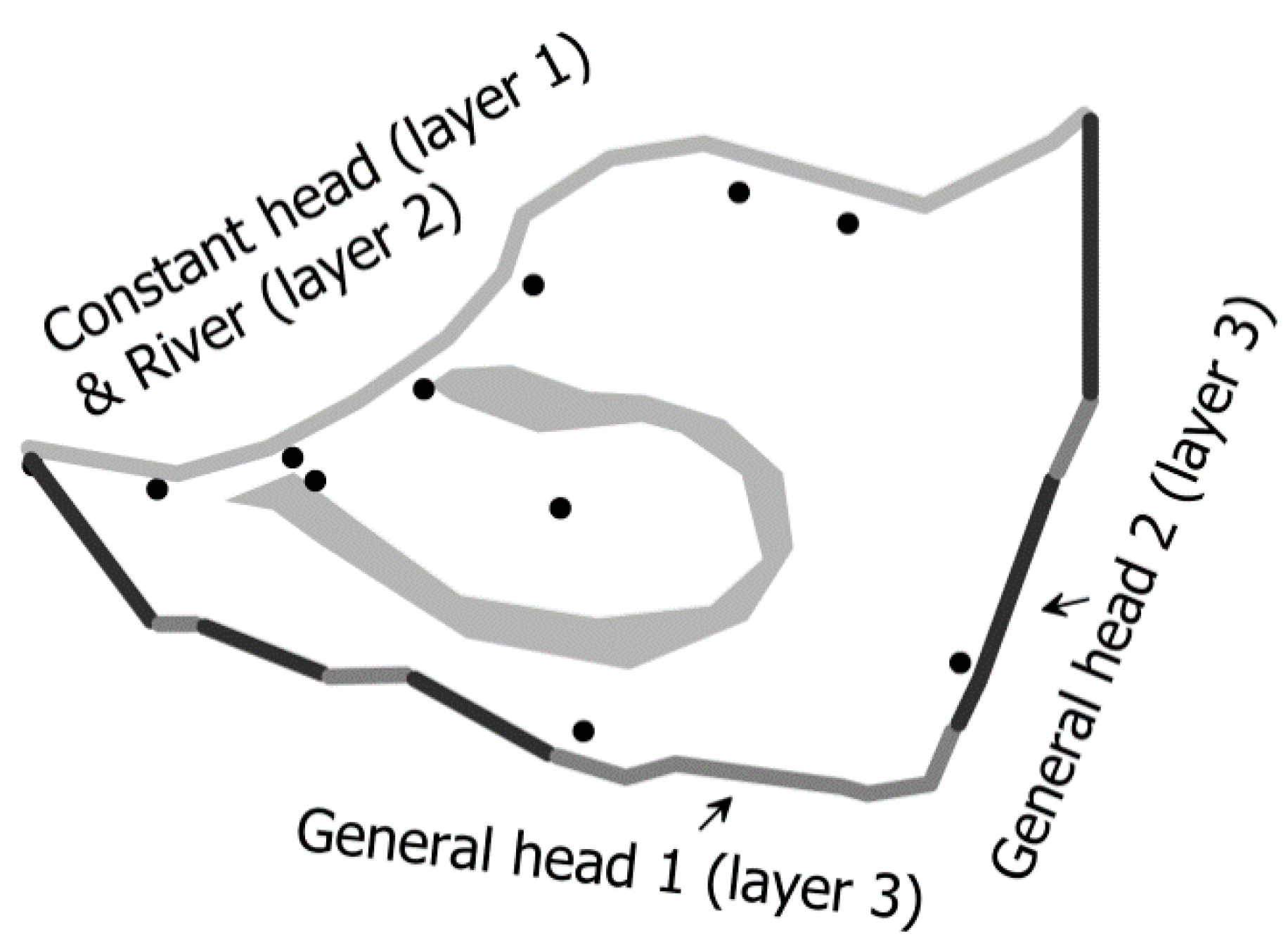
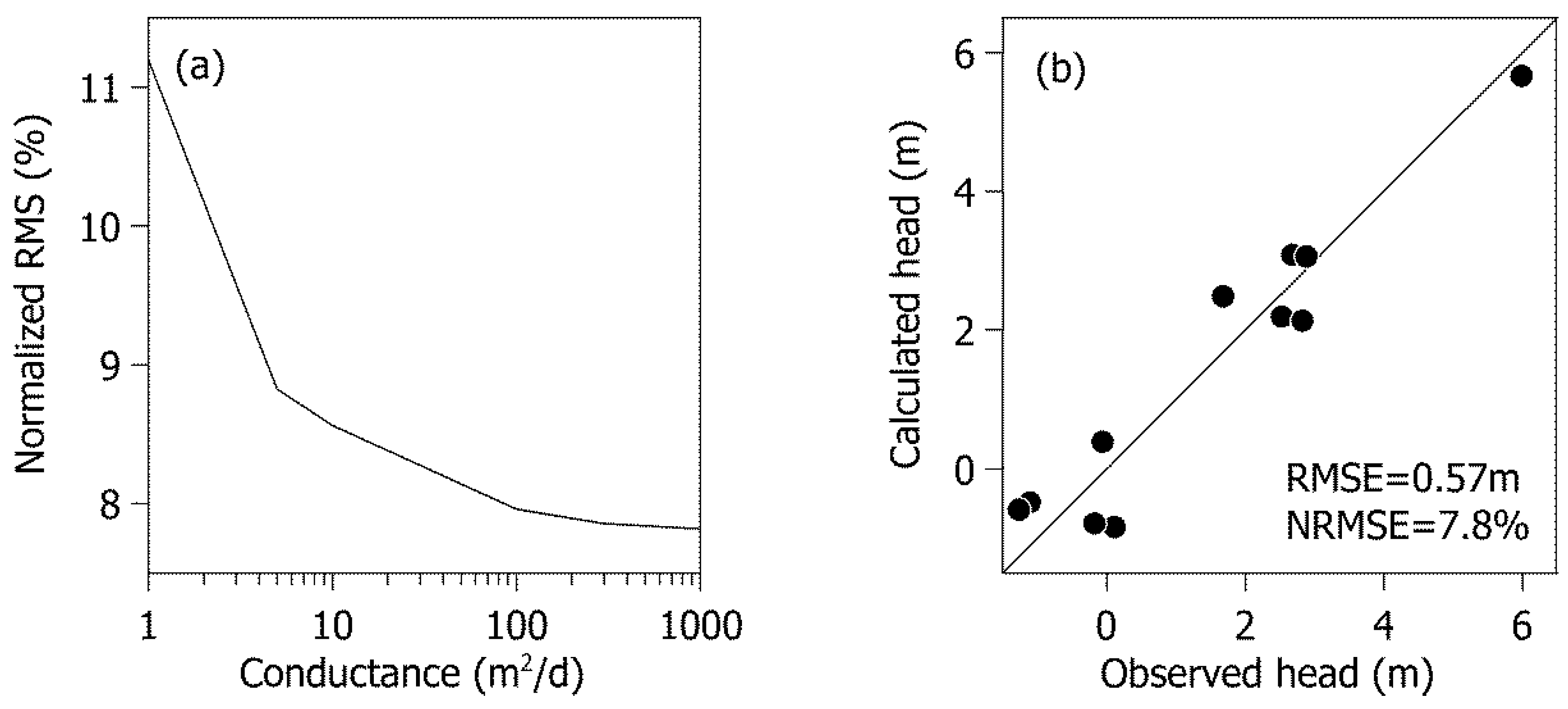
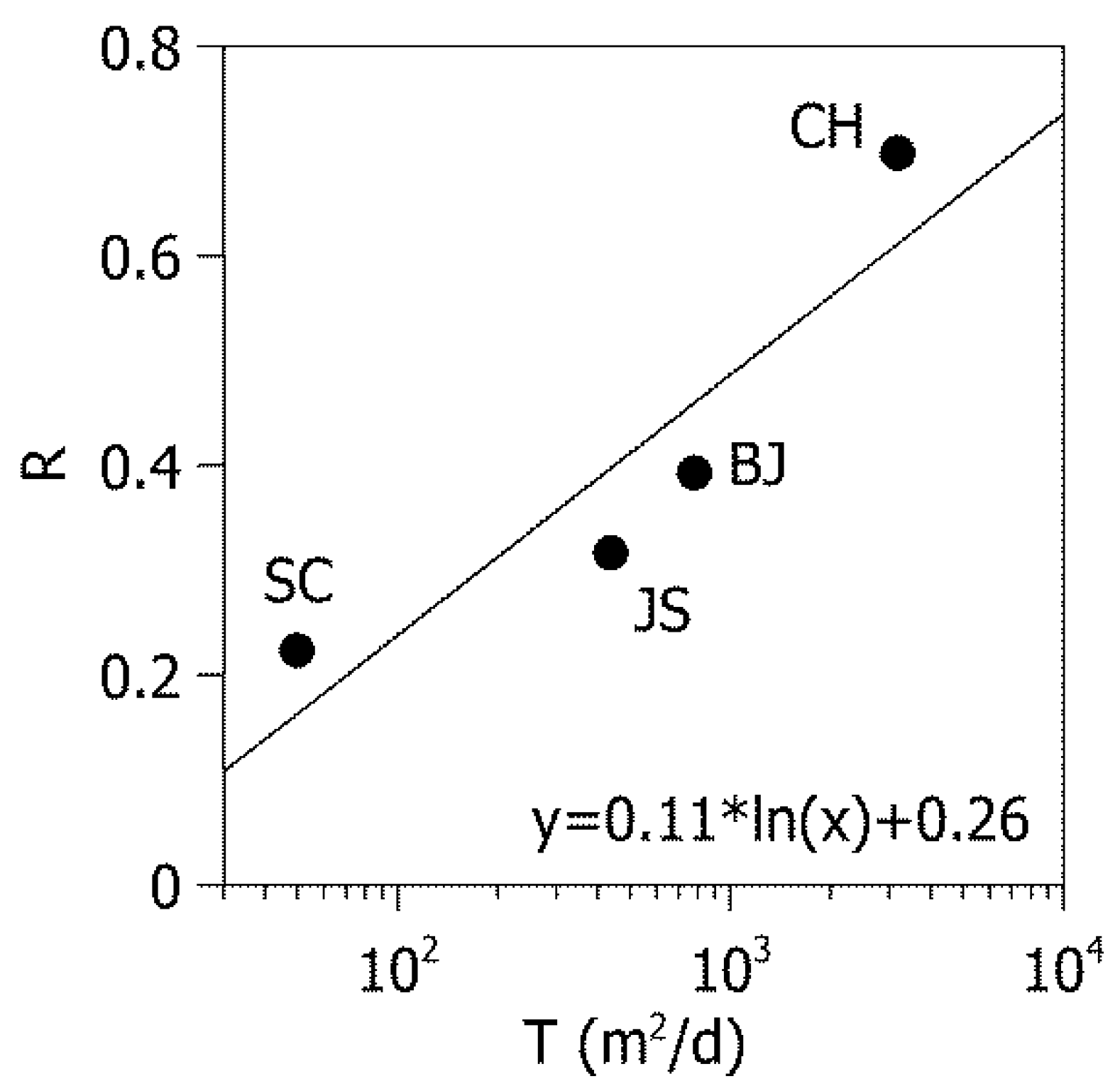
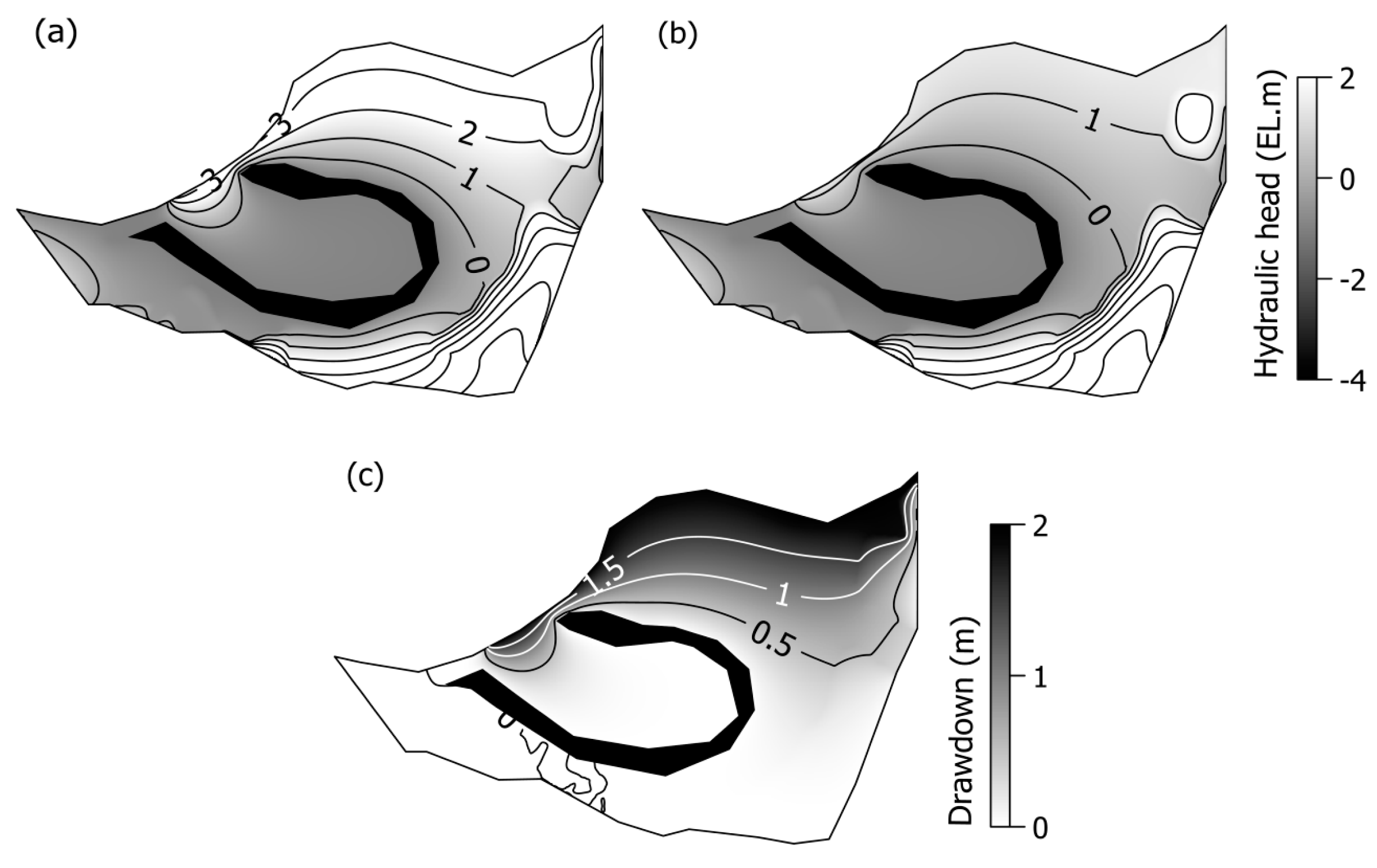


| Before Weir Opening (Management Level: 3.5 m) | After Weir Opening (Management Level: 1.5 m) | |||||
|---|---|---|---|---|---|---|
| In | Recharge | 2800 | total: 21,000 | 2800 | total: 15,000 | |
| River | Upstream of weir | 13,000 | 6900 | |||
| Hinterland | 5250 | 5260 | ||||
| Out | River and ox bow | Upstream | 6 | total: 21,000 | 40 | total: 15,000 |
| Down-stream | 6800 | 4400 | ||||
| Oxbow lake | 13,000 | 10,000 | ||||
| Hinterland | 700 | 570 | ||||
Publisher’s Note: MDPI stays neutral with regard to jurisdictional claims in published maps and institutional affiliations. |
© 2021 by the authors. Licensee MDPI, Basel, Switzerland. This article is an open access article distributed under the terms and conditions of the Creative Commons Attribution (CC BY) license (https://creativecommons.org/licenses/by/4.0/).
Share and Cite
Lee, H.; Koo, M.-H.; Lee, J.; Kim, K. Changes in Stream–Aquifer Interactions Due to Gate Opening of the Juksan Weir in Korea. Water 2021, 13, 1639. https://doi.org/10.3390/w13121639
Lee H, Koo M-H, Lee J, Kim K. Changes in Stream–Aquifer Interactions Due to Gate Opening of the Juksan Weir in Korea. Water. 2021; 13(12):1639. https://doi.org/10.3390/w13121639
Chicago/Turabian StyleLee, Hyeonju, Min-Ho Koo, Juhyeon Lee, and Kangjoo Kim. 2021. "Changes in Stream–Aquifer Interactions Due to Gate Opening of the Juksan Weir in Korea" Water 13, no. 12: 1639. https://doi.org/10.3390/w13121639
APA StyleLee, H., Koo, M.-H., Lee, J., & Kim, K. (2021). Changes in Stream–Aquifer Interactions Due to Gate Opening of the Juksan Weir in Korea. Water, 13(12), 1639. https://doi.org/10.3390/w13121639






